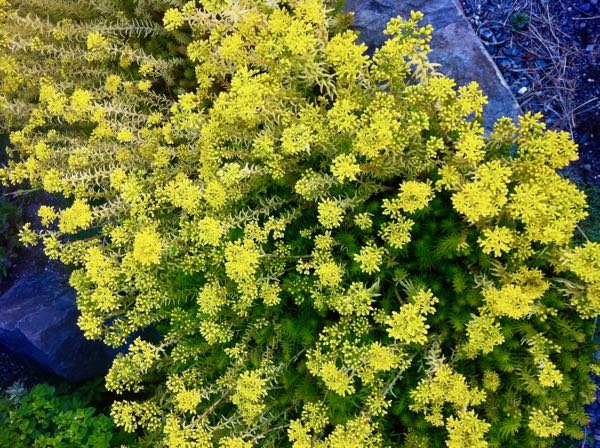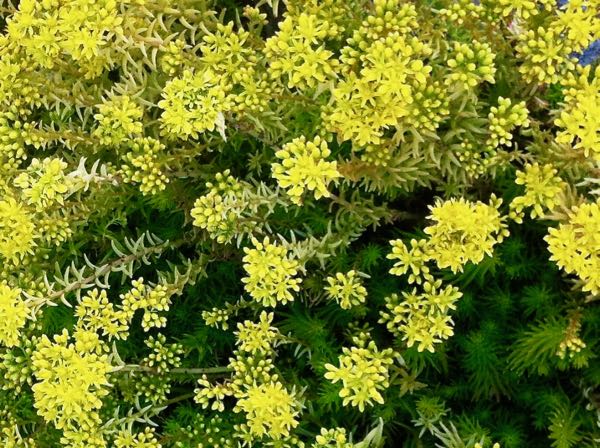Sedum rupestre: A Hardy Succulent Ground Cover
Sedum rupestre, also known as Sedum reflexum or Reflexed Stonecrop, belongs to the Crassulaceae family of plants. This mat-forming succulent perennial is native to Southern Europe and has gained popularity worldwide for its striking appearance and low maintenance requirements. In addition to its scientific name, Sedum rupestre is known by various common names, including Stonecrop, Jenny’s Stonecrop, Blue Stonecrop, Trip Madam, Prick Madam, and Stone Orpine.

Distinctive Features: Blue-Green Needles and Vibrant Yellow Flowers
Sedum rupestre is a compact plant that typically reaches a height of around 10cm or 4 inches. Its dense, low-growing habit and spreading nature make it an excellent choice for ground cover in gardens and landscapes. The standout feature of Sedum rupestre is its blue-green needle-like leaves, which resemble the foliage of the blue spruce tree. The foliage forms dense mats, creating a visually appealing carpet effect.
In early to mid-summer, Sedum rupestre produces charming star-shaped flowers that add vibrant pops of color to the plant. The flowers appear on stalks that reach approximately 6 inches or 15 centimeters in height. The blossoms themselves are a bright yellow hue, creating a stunning contrast against the blue-green foliage. Beyond their aesthetic appeal, these yellow flowers also attract pollinators such as bees and butterflies, contributing to the overall ecological value of the plant.
Cultivation of Sedum rupestre:
Sedum rupestre is a hardy and adaptable plant, making it suitable for a range of growing conditions. Here are some key considerations for successful cultivation:
Sunlight Requirements: Sedum rupestre thrives in sunny to lightly shaded areas. It requires several hours of direct sunlight each day to promote healthy growth and vibrant flower production.
Soil Conditions: This plant prefers moderately fertile to poor soil with good drainage. Well-drained soil helps prevent waterlogged conditions that can lead to root rot. It can tolerate a range of soil types, including sandy or rocky soils.
Moisture Levels: Sedum rupestre is well-suited to dry to medium moisture conditions. While it can withstand short periods of drought, it’s essential to provide regular watering during extended dry spells to ensure optimal growth and prevent excessive wilting.
Maintenance: Sedum rupestre is generally disease-free and pest-resistant, requiring minimal maintenance. Prune back any dead or faded flower stalks to encourage new growth and maintain the plant’s neat appearance. Deadheading the flowers can also prolong the blooming period. Additionally, removing any weeds that may compete for resources is beneficial.
Propagation: Sedum rupestre can be propagated through softwood cuttings, allowing you to expand your collection or share this delightful plant with others. Take cuttings from healthy stems, plant them in well-draining soil, and provide adequate moisture until new roots develop.

Culinary Uses: A Unique Flavor for Salads
Interestingly, Sedum rupestre has culinary applications in certain parts of Europe. Its sour taste adds a distinctive flavor to salads and other culinary preparations. In traditional cuisines, the leaves of Sedum rupestre are harvested and used as a tangy ingredient, adding a touch of acidity to dishes. However, it’s important to note that not all sedum species are edible, so proper identification is crucial before considering its culinary use.
Sedum rupestre, with its mat-forming growth habit, blue-green needle-like leaves, and vibrant yellow flowers, is a charming and versatile plant. Its ability to thrive in sunny, well-drained conditions and its minimal maintenance requirements make it an excellent choice for ground cover, rock gardens, or container plantings. Whether you appreciate its ornamental value or its unique culinary potential, Sedum rupestre is sure to add beauty and interest to your garden or landscape.
Also, you may enjoy reading about Sedum telephium ‘Purple Emperor’



